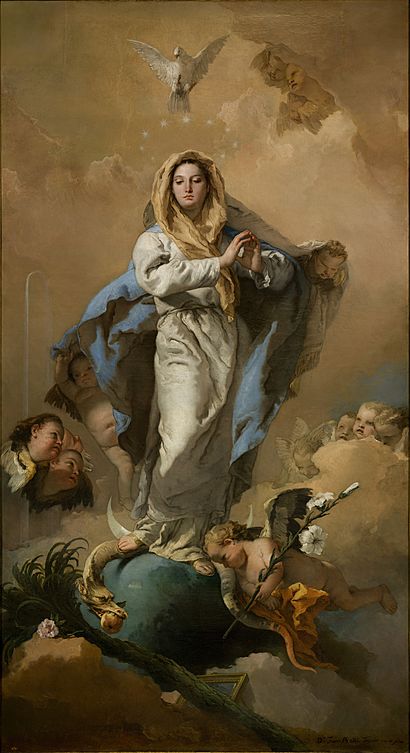The Immaculate Conception (Tiepolo) facts for kids
Quick facts for kids The Immaculate Conception |
|
|---|---|
 |
|
| Artist | Giovanni Battista Tiepolo |
| Year | 1767–1768 |
| Medium | Oil on canvas |
| Dimensions | 115 cm × 170 cm (3' 10" × 5' 5" ) |
| Location | Prado Museum, Madrid |
The Immaculate Conception is a famous painting by the Italian artist Giovanni Battista Tiepolo. He painted it between 1767 and 1768. This artwork was one of seven large paintings that King Charles III of Spain asked Tiepolo to create for a new church in Aranjuez, Spain.
The painting shows the Virgin Mary in a special way. It represents the Immaculate Conception, a belief in the Catholic Church. This belief says that Mary was born without original sin, which is a concept about human nature. The idea of the Immaculate Conception was already popular in art when Tiepolo painted this. Today, the painting can be seen at the Prado Museum in Madrid.
After the paintings were first put in the church, they were moved to a nearby convent. Later, in 1827, The Immaculate Conception was moved to the Prado Museum, where it is still displayed.
About the Painting
This painting uses a grand Baroque style, which means it's designed to create strong feelings. It was finished between 1767 and 1768.
What the Painting Shows
The painting shows the Virgin Mary in a traditional way. She represents the Immaculate Conception, meaning she is free from original sin. You can spot several important symbols in the painting:
- A dove is above her head, symbolizing the Holy Ghost.
- Stars surround her head, forming a crown.
- She stands on a crescent moon.
- A snake is crushed under her feet, showing her victory over evil.
- Her hands are together in prayer.
- An obelisk (a tall, thin monument) is on her right.
Other symbols that fit this theme include clouds and small cherubs (angelic figures). You can also see lilies and a pink rose. These flowers are often linked to Mary. Lilies mean purity, and the rose is a symbol for Mary as the Queen of heaven and earth.
The globe under her feet represents the world. The crescent moon and starry crown are traditional symbols of the "woman clothed with the sun." This image comes from a Bible passage in Revelation 12:1-2. The crescent moon also stands for purity. It shows that Mary's special grace comes from her son, Christ, just as the moon gets its light from the sun.
The obelisk on her right shines in the sun's light. It represents strength, purity, and Mary's virginity. Mary is shown stepping on a serpent that holds an apple. This serpent stands for the one in the Garden of Eden and Original Sin. A palm branch and a mirror are also under her feet. The palm branch means Mary's victory, and the mirror means her purity.
Earlier Versions and Studies
The way this painting shows the Immaculate Conception became very popular. Tiepolo had painted an earlier version in 1734 for a church in Vicenza, Italy. That painting showed Mary as a young girl. The current version, however, shows Mary in a more grand and serious way. This style fit the strict traditions of the monastery it was made for.
Tiepolo also painted five smaller study paintings, called modelli, for his large altarpieces. These modelli are now in London at the Courtauld Institute of Art. They are considered some of his best works. The modello for The Immaculate Conception is a bit different from the final painting. In the final version, Mary takes up more space. Also, a strong angel that was in the modello is not in the final painting. This angel might have represented archangel Michael.
Art Style
Baroque art aimed to create strong feelings and excitement. It was different from the calm and logical art of the Renaissance. Tiepolo's paintings are often very large. They are known for their energy, richness, and detailed designs. Many of his most popular works show stories from mythology and religion. They create a feeling of greatness and beauty.
See also
 In Spanish: Inmaculada Concepción (Tiepolo) para niños
In Spanish: Inmaculada Concepción (Tiepolo) para niños
- Marian art in the Catholic Church
- Woman of the Apocalypse
- Virgo in Sole



